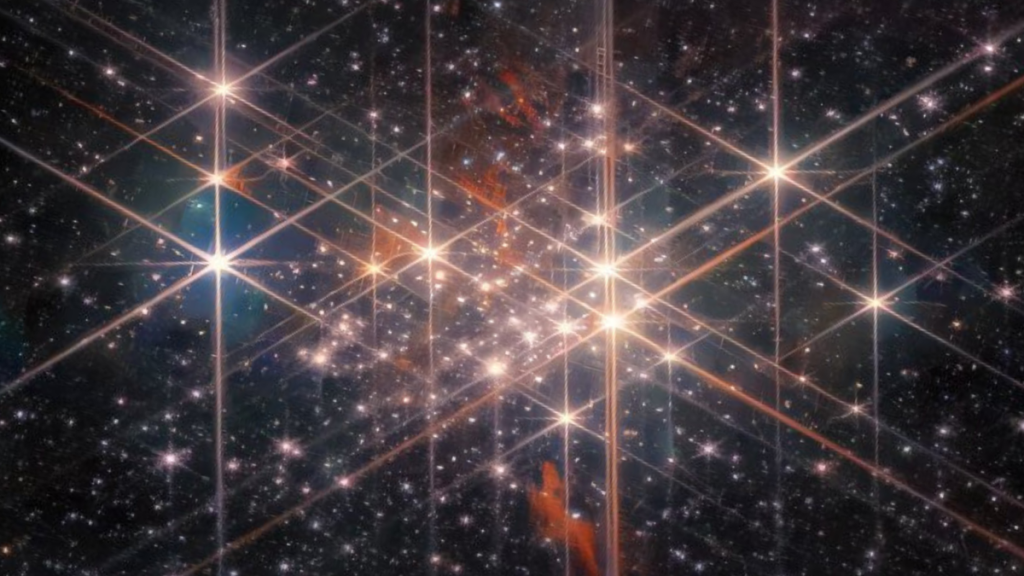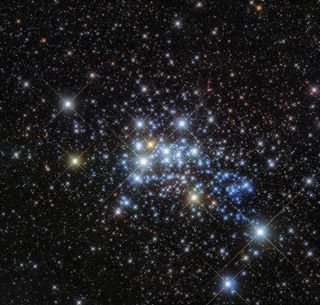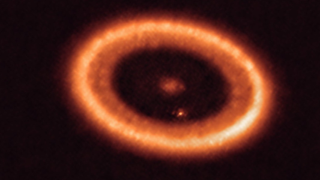
James Webb Space Telescope explores monster star supercluster Westerlund 1 (image) (Image Credit: Space.com)
Using the James Webb Space Telescope, astronomers have taken a deep drive into a highly intriguing and massive young stellar cluster in the Milky Way. It’s called Westerlund 1. Located around 12,000 light years from Earth, Westerlund 1 is also the closest supermassive star cluster to us.
Supermassive star clusters like Westerlund 1 are groupings of stars that contain masses equivalent to tens of thousands of suns. In these superclusters, the processes that favor star-forming environments and boost the births of stars and planets are extremely efficient.
At over 6.6 light-years wide, Westerlund 1 has a mass the same as around 63,000 suns. Hosting the largest and most compact population of monster stars in the Milky Way, with hundreds of very massive stars packed in a relatively small region, Westerlund 1 is a tantalizing target for astronomers aiming to better understand a range of stellar phenomena and the evolution of planetary systems.
The new image and associated findings regarding Westerlund 1 were delivered by the Extended Westerlund 1 and 2 Open Clusters Survey (EWOCS).
“We pushed our detection limit down to the brown dwarfs of the cluster, which are the smallest stars that can form!” EWOCS team leader Mario Giuseppe of the Palermo Astronomical Observatory in Italy told Space.com. “Thus, we will be able to determine the true content of the cluster and to measure properties such as the mass distribution of its stars.”
The James Webb Space Telescope (JWST) also offers detailed and deep observations taken in infrared wavelengths of light that can be used to highlight young stars still surrounded by planet-birthing protoplanetary disks.
“These may be forming planets right now,” Giuseppe continued. “All this will allow us, for the first time, to determine the impact of the starburst environment on the products of star formation and the process of planet formation.”
Westerlund 1 is one wonderland for astronomers
EWOCS not only works with observations from the JWST, but also with data from the Hubble Space Telescope, the Atacama Large Millimeter/submillimeter Array (ALMA), NASA’s Chandra X-ray Space Telescope, and more, to study Westerlund 1 as well as the slightly more diminutive supercluster Westerlund 2.
“Westerlund 1 hosts the largest and most compact population of massive stars we know in the galaxy, with hundreds of very massive stars packed in a very small region, almost all of them being in close binary systems,” Giuseppe said. “In such cases, the star-forming environment is dominated by energetic radiation [UV and X-rays] and high-speed, high-energy particles, which regulate star and planet formation.”
A range of different conditions in galaxies can determine the rate at which stars form. As an example, epochs of intense star birth, known as “starburst periods,” can be triggered when galaxies collide to cause an influx of gas and dust, which are the building blocks of new stars.
“In these cases, the typical star-forming environment takes the form of very massive and supermassive star-forming regions,” Giuseppe said.
Such instances were more common in the early and turbulent universe when galactic collisions were more likely to occur. Formation rates have been quenched in the Milky Way because it’s a “modern” galaxy, meaning starburst regions are few and far between.
“The Milky Way today hosts only a few supermassive clusters, with less than ten known,” Giuseppe continued. “These few regions are crucially important because they allow us to study star- and planet-forming conditions which are typical of starburst galaxies in the early universe and to extend our knowledge of star and planet formation to the most extreme and energetic star-forming environments we know of.”
That is what makes the study of Westerlund 1, one such region, so important.
Superclusters are often obscured by clouds of gas and dust between stars in the Milky Way and are usually buried in dense star fields. That means studying these sites of intense star formation, especially when investigating lower-mass stars in the region, requires a powerful telescope with a large light-gathering area that can capture infrared light, which, as briefly touched on, is capable of slipping through dense clouds of interstellar matter. Visible light cannot do that.
That’s why the EWOCS team turned to the JWST and its main tools, the Mid-Infrared Instrument (MIRI) and the Near-Infrared Camera (NIRCam). Though Westerlund 1 has been studied by many other telescopes, including Hubble, the JWST still provided Giuseppe and colleagues with some unexpected results.
“The main surprises arrived from the MIRI images, that unveiled a dense and structured nebulosity [gas and dust] all around and within the cluster,” the researcher said. “Such nebulosity can hardly be a remnant of the parental cloud from which the cluster formed about 5 million years ago.”
This is because young clusters with a moderate population of massive stars create large cavities in their clouds over the course of less than one million years.
“Westerlund 1 hosts the most massive star population known in a galactic cluster, and it is at least 5 million years old, so it should have cleaned up all its clouds,” Giuseppe said. “In the MIRI images, we think we are witnessing the accumulation of intracluster material from the gas and dust ejected by the most massive stars of the clusters during their final stages of evolution, and the interaction between the winds produced by different types of massive stars.”
Giuseppe added that the MIRI images also revealed peculiar outflows and shells around the most evolved massive stars in Westerlund 1.
“In the next two to three years, we will publish most of the EWOCS science,” Giuseppe said. The researcher explained that the next release will be a study of the hot intracluster gas in the cluster, studied by means of the diffuse emission in X-rays.
The EWOCS team will then release an analysis of high-energy phenomena happening in some of the compact objects in Westerlund 1 as well as calculate the mass distribution of low-mass stars in the cluster. The researchers also intend to analyze the disk-bearing population of the cluster, and conduct a study of outflows around the most evolved stars in the region, namely red supergiants and yellow hypergiants.
“That is just to mention a few. All these studies will be possible not only thanks to JWST but also other great observatories such as Chandra in X-rays, ALMA and Hubble,” Giuseppe concluded. “Besides these, the analysis of the observations of Westerlund 2, a slightly less massive but younger cluster than Westerlund 1, is at a good stage, and we will start publishing those results soon.”
The team’s research has been accepted for publication in the journal Astronomy & Astrophysics and is available as a preprint on the repository site arXiv.








